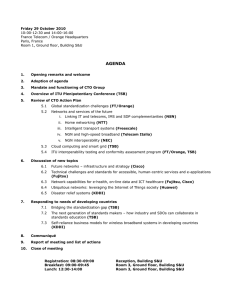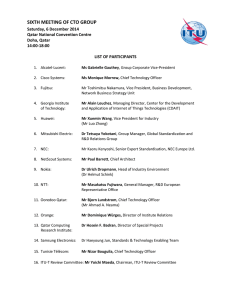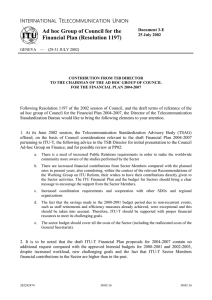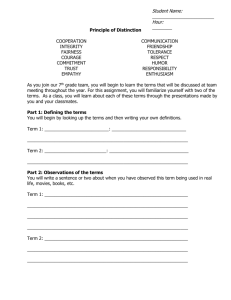Authoring Recommendations Tips for streamlining editing International Telecommunication Union
advertisement
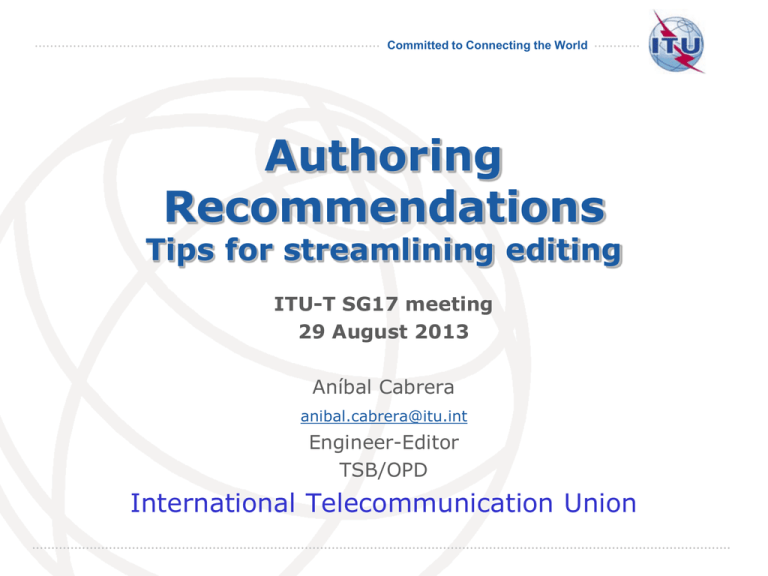
Committed to Connecting the World Authoring Recommendations Tips for streamlining editing ITU-T SG17 meeting 29 August 2013 Aníbal Cabrera anibal.cabrera@itu.int Engineer-Editor TSB/OPD International Telecommunication Union International Telecommunication Union Committed to Connecting the World Objectives Foster a closer working relationship between study group rapporteurs and editors and the TSB editing unit Identify ways in which SG authors, editors and rapporteurs could contribute to shortening the publication delay while at the same time enhancing the quality of Recommendations July 2013 2 Committed to Connecting the World Agenda Standardizing at a faster pace Prepublication, editing at TSB, publication Editing tips Pre-approval assessment and editing July 2013 3 Committed to Connecting the World Streamlining Editing In the past CCITT used to issue Recommendations every 4 years July 2013 4 Committed to Connecting the World ITU-T TAP approval procedure July 2013 5 Committed to Connecting the World ITU-T AAP approval procedure Approved LC 4 weeks (a) 4 SG or WP meeting (1) Edited Director's text announcement for LC and posting (2) for LC (3) 3 weeks (b) (c) Comment resolution (7) (a) 9 LC: AR: Last Call Additional Review AR 3 weeks (b) Edited Director's text announcement for AR and posting (8) for AR (10) Approved Director's SG announcement Meeting and posting (6) ( 5 ) (b) Approved 11 (a) Director's notification and publication (see ITU-T. A.11) (12) A.8(08)_F01 July 2013 6 Committed to Connecting the World Streamlining Editing In 2012 TSB published 340 Recommendations and amendments throughout the year (over 14000 pages) July 2013 7 Committed to Connecting the World TSB editing and publication unit • Has ambitious publication objectives • On-going adaptation of procedures • Introduced new electronic working methods • Introduced editorial assessment and preapproval editing (for stable texts) July 2013 8 Committed to Connecting the World Editing a Recommendation The SG author/editor/rapporteur writes the Recommendation and defines: • • • • • • Scope Presentation Content Length Level Organization References: • WTSA Resolution 1 • Recommendation ITU-T A.8 • Author’s guide • English Language style guide Clause 2.3.3.8 of ITU-T A.1 states: "Rapporteurs are responsible for the quality of their texts, submitted by the study group for publication. They shall be involved in the final review of that text prior to it being submitted to the publication process." After approval, the Recommendation is sent to the TSB Editing Unit who verifies figures and checks for consistency and sense Checks for consistency • • • • • • • Language House style Abbreviations Cross-references References Bibliography Numbering of tables, notes, clauses, figures, annexes, appendices, equations July 2013 Checks for sense • Ambiguity • Contradiction • Descriptive text of tables and figures Figure redrawing • House style • Clarity • Precision 9 Committed to Connecting the World Publication timeline Consented/ Determined New Rec. is approved Prepublished Published TSB editing Revision or amendment is approved Revision/ amendment Revision is developed based on the published version (latest snapshot) Written specification is ‘frozen’ between snapshots July 2013 10 Committed to Connecting the World Publication timeline Revision drafted based on prepublished (not published) text Revision or amendment is consented before previous edition is published Consented/ Determined New Rec. is approved The standard continues to be developed New Rec. Prepublished Rev. New Rec. Prepubl. Published Rev. Published TSB editing Revision was not based on published version (publication takes longer) July 2013 11 Committed to Connecting the World Reducing publication delay - A bigger editing team - Approve less documents - Streamline further editing procedure Spiral effect Making Recommendations publicly available soon after approval allows for the development of revisions based on the previously published version, which allows the revision to be made publicly available soon after approval, which allows for the development of new revisions based on the previously published version, which allows the new revision… July 2013 12 Committed to Connecting the World Reduce the publication delay? SG counsellor Editing assistants SG assistants TSB editor SG editors SG rapporteurs Authors Draftspersons July 2013 13 Committed to Connecting the World Help reduce the delay The dynamism of the market may require continuous development of a standard, including parallel development of several parts of a Recommendation. However, having multiple revisions or texts not based on latest published version may lead to confusion. Build on the latest published version when drafting revisions and amendments. Ensure that parallel developments are introduced into the text in a sequential manner and that modifications introduced earlier amendments and corrigenda have been included. July 2013 14 Committed to Connecting the World Help reduce the delay Recommendations are written by experts in the field using highly technical language. When needed, TSB editors contribute to the end result by aligning the text to the English language house rules (English Style guide). The amount of editing done by TSB editors is limited by the fact that Recommendations have already been seen and approved by the Members. Ensure that ideas and concepts have been expressed in a clear, unambiguous manner before the text is submitted for approval. July 2013 15 Committed to Connecting the World Help reduce the delay Many Recommendations, especially amendments, are developed by several authors who introduce revision marks in text that already contains revision marks introduced by other authors. Ensure that only the final intended changes to the base text are reflected in revision marks. July 2013 16 Committed to Connecting the World Help reduce the delay TSB redraws figures that require text editing or that depart too much from the TSB editorial style. This drawing stage takes time and often results in long publication delays, especially if figures have to be drawn from scratch. Whenever possible, submit figures in a vector format, which TSB will be able to use for editing. If a new figure is actually a revision to a figure that had been previously drawn by TSB, cross-out the TSB figure identifier, or add “(MOD)” after the identifier. July 2013 17 Committed to Connecting the World Help reduce the delay English style guide: “Too many capital letters in a sentence or column of type tend to distract the reader's attention. For this reason, and contrary to many authors’ tendency, as few initial capitals as possible should be used in ITU documents and publications.” There is a tendency to use many initial capitals in technical texts; TSB editors will make them lower case from a grammatical point of view. However, it is not always clear which capital letters are actually required by the protocol. Use initial capitals only when required by English grammar or by a convention (e.g., for protocol elements, names of commands, variables, etc.) Indicate in clause 5 (Conventions) any naming conventions for protocol elements, entities, etc. …. When ASN.1 types and values are referenced in normal text, they are differentiated from normal text by presenting them in the bold Courier New typeface. The names of procedures are differentiated from normal text by displaying them in bold Times New Roman. Access control permissions are presented in italics…. July 2013 18 Committed to Connecting the World Help reduce the delay Recommendations sometimes include text or figures extracted from sources external to ITU. Before submitting a Recommendation for approval, ensure that we have the necessary copyright permissions for publishing text and figures extracted from external sources. IPR page: http://www.itu.int/en/ITU-T/ July 2013 19 Committed to Connecting the World Help reduce the delay TSB cannot publish Recommendations that contain references to draft documents or to documents that are not publicly available. Before submitting a Recommendation for approval, verify that all normative (clause 2) and bibliographic references are valid, stable and accessible by external readers. Verify that clause 2 references are actually being used normatively and that bibliographic references are being used in a non-normative manner. It’s a good idea to include links to documents that are not easy to find on the web. July 2013 20 Committed to Connecting the World Help reduce the delay Use conventional sequential numbering for annexes, appendices, clauses, figures and tables. Good practice: Start numbering anew for each top-level clause (Table 6-5, then Table 7-1, Figure 8-2 then Figure 9-1, etc.). This will allow for an easier insertion of new figures and tables without having to shift numbering too much. Annexes are numbered sequentially using capital letters (A, B, C…), except I, to avoid confusion with Appendix I. Appendices are numbered sequentially using Roman numerals (I, II, III…). July 2013 21 Committed to Connecting the World Pre-approval assessment and editing (AAP) Procedure put in place in October 2012 that allows the Editing Unit to provide editorial advice or to edit a Recommendation before it is submitted for approval. • • • • Applied to stable text The counsellor, in agreement with the editor/rapporteur, initiates the procedure Depending on the stability of the text, the counsellor may request global editorial advice or full-text editing from the Editing Unit Fully-edited Recommendations are published soon after approval July 2013 22 Pre-approval assessment and editing (AAP) Committed to Connecting the World SG, WP or Rapp meetings Initial draft Preferred A Draft Stable? C B 2-3 months 0 weeks Draft is modified by contributions B1 Y SG or WP meeting Modified further TD Plen is generated Consent N AAP LC + AR 4+ weeks A/AT/AC Rec. is prepublished Prepubl Req Dispatch Rec. is published July 2013 Publ Req SG secretariat Rec. is edited 23 Committed to Connecting the World Reference documents: • Author’s guide (http://www.itu.int/oth/T0A0F000004/en) • English Language style guide (www.itu.int/SG-CP/docs/styleguide.doc) • ITU-T A.5 If you are drafting a Recommendation and have editorial questions, you can always ask the TSB editor anibal.cabrera@itu.int The editing team will reply! July 2013 24 http://www.itu.int/en/ITU-T 25


